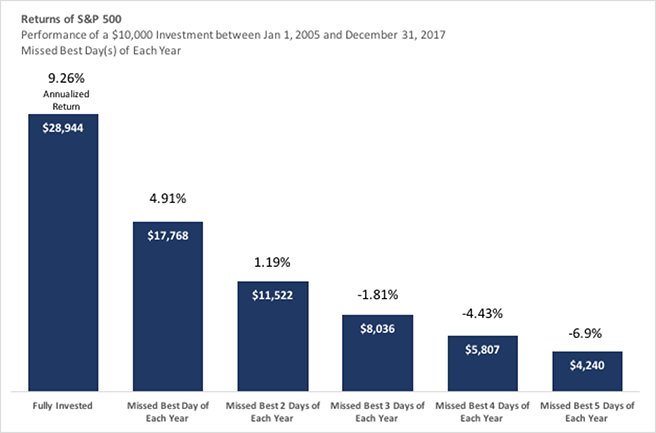It’s human nature to try to optimize performance; however, when it comes to investing, a disciplined, long-term approach wins.
By Mark Stoeckle
February 4, 2018
Timing the market, where investors buy and sell securities more frequently in an attempt to capture gains and avoid losses, is challenging for any investor no matter how sophisticated they may be. Too often, investors buy and sell at the wrong time and for the wrong reason, with disappointing results. At Adams Funds, we believe the case against market timing is compelling.
Investors often hear the advice that you should buy and hold investments for the best returns over the long-term. In bull markets, it is easy to follow this advice. The difficult part comes when markets go down and our instincts tell us to sell stocks to preserve capital. This is when it rarely pays to trust your gut.
It’s the time in the market, not timing the market, that allows investors to channel the power of compounding returns.

Research shows that timing the market is extremely difficult and investors are better off staying fully invested over the long-term. Whether working with an advisor or on your own, an important part of any long-term strategy is rebalancing your investment choices and your tolerance for risk annually.
By staying invested, and holding steady during both the ups and downs of the markets, investors can benefit from compounding. This refers to the cumulative effect of reinvesting earnings, interest, dividends, and capital gains consistently and over time to facilitate exponential growth. The longer an individual’s time horizon, the more time their investment has to reap the advantages of compounding.
Timing the market is extremely difficult. There are those who will sell at the first sign that stocks might be entering a downturn to lock in gains. These investors often sit on the sidelines too long and do not re-enter the market until prices are high again, missing out on valuable appreciation.
Then there are those investors who wait until a bear market is well underway before selling. As the market continues to go down, these investors eventually give in to their emotions and end up selling at what inevitably is close to the bottom.
According to research from Hulbert Financial Digest, since March 2009, which was the bottom of the financial crisis, 98% of market timers have underperformed a buy-and-hold strategy. This underscores not only the difficulty in trying to time the market, but also the fact that to profit by timing, investors must do it correctly nearly every time. Only the most sophisticated market timers can do this.
Richard Thaler, a pioneer in the study of behavioral economics, observed through his research that when individual investors try to time the market, most will invariably sell low and buy high. His work, for which he earned a Nobel Prize in October 2017, focuses on the psychological biases that subconsciously, and unfavorably, influence financial decisions. Thaler found that investors would be better off if they avoided the inclination to panic when markets go down.
Morningstar, last year, found that over the past decade the performance of the average investor in diversified equity funds lagged the average fund return by over 75 basis points, a shortfall the research firm attributed to bad market timing. Investors following a buy-and-hold strategy, on the other hand, outperformed the average fund return by more than 15 basis points, which equates to a total differential of nearly 1.0% (90 basis points). This speaks to the value of maintaining a consistent investment strategy over time and across cycles.
Advisors often quantify the impact of market timing by highlighting how much investors who try to time the market stand to lose if they miss the market’s best days. A study conducted by University of Michigan’s Dr. Nejat Seyhun, which tracked stock market returns in the 40 years between 1963 and 2004, found that 96% of the gains were generated in fewer than 1% of the total trading sessions. The table below shows a $10,000 investment in the S&P 500 made on January 1, 2005, would have grown to nearly $28,944 as of the end of 2017. Taking out just the one best day each year the return is 38.6% less at $17,768. The return continues to decline by simply taking out one additional day each year for five years.

Additional data shows the best trading days also tend to occur near the worst market drawdowns. Again, this only amplifies the challenge to accurately predict the direction of the market during periods of high volatility. Flash back to 2008, for instance, when the S&P 500 plummeted by 9% on October 15, but the session was sandwiched in between two of the biggest market advances ever on October 13 and October 28.
The message is clear, it’s the time in the market, not timing the market, that allows investors to channel the power of compounding returns and capture the best upward moves in the market. Ultimately this is what drives long-term performance.
The investment team at Adams Funds takes a long-term view when constructing the portfolios of our Funds. We utilize a disciplined process to add and remove companies from the portfolio. It is this discipline that enables us to reduce the behavioral biases to sell good companies when markets go down. We recognize that the U.S. stock market is in the ninth year of the second longest bull market in history. However, we believe the best strategy is to remain fully invested and to focus on identifying good companies that are executing at the highest levels and are trading at attractive valuations.
Even if you are not invested in Adams Funds (and we hope you are), the important message is to invest for the long term, review your asset allocation annually, and be honest about how much risk you want to take. And most importantly, Stay Invested.


